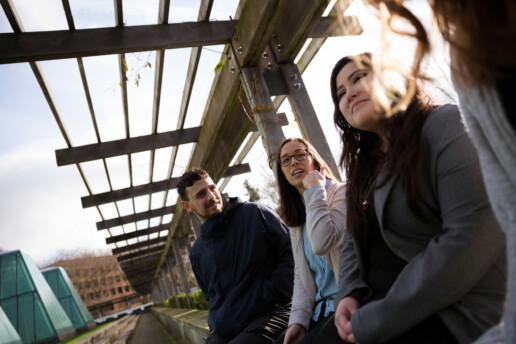Guest Post: Legal Education and the Illusion of Inclusion
Guest Post: Legal Education and the Illusion of Inclusion
 Shaun Ossei-Owusu
Shaun Ossei-Owusu
Presidential Assistant Professor of Law
University of Pennsylvania Carey Law School
A new semester and a potentially new political landscape are upon us. Last month law students around the country resumed coursework. Their educational pursuits are virtual, in-person, or some mix of both. No matter the format, law students continue their educational journey in an ideologically polarized pandemic society where race, class, and gender disparities are on sharp display.
Students will also be learning in a context where changes in our legal system may have direct relevance to their legal education. As is typically the case, a newly constituted Supreme Court has a diverse docket this term that might shape substantive areas of law that students take courses in, chiefly constitutional law. There will be regulatory shifts that come with new administrations. These kinds of changes will have meaning for administrative law and related areas of law: health law, environmental law, employment law, and civil rights, to name a few. COVID-19 has upended state and federal judiciary systems in ways that have still-undetermined implications for procedural courses law students take (e.g., evidence, civil procedure, criminal procedure) and access to justice issues more generally. And we know from the late Deborah Rhode’s work which communities access to justice issues tend to devastate—racial minorities, women, and other marginalized populations.
Notwithstanding future uncertainty, one thing can be said with some measure of confidence: issues of race and gender—amongst other social categories—will remain relevant inside and outside the sometimes intellectually-cordoned off walls of law schools. How these issues are integrated in the classroom, if they are at all, will affect the substantive learning of law and will either include or exclude historically marginalized groups.
In the specific context of legal education, the results of Law School Survey of Student Engagement’s (LSSSE) Annual Survey illuminate. The Report provides a glimpse into how law schools fail to meet the aspirational goal of inclusion that often takes up primetime real estate on their websites and promotional materials. From my own read, the most jaw-dropping finding is intersectional in nature and about Black and Latinx women law students—aspiring attorneys who are often told that they do not look like lawyers when they transition to practice. 26% of Black women respondents and 17% of Latinx women respondents reported that their schools do “very little” to support racial and ethnic diversity.
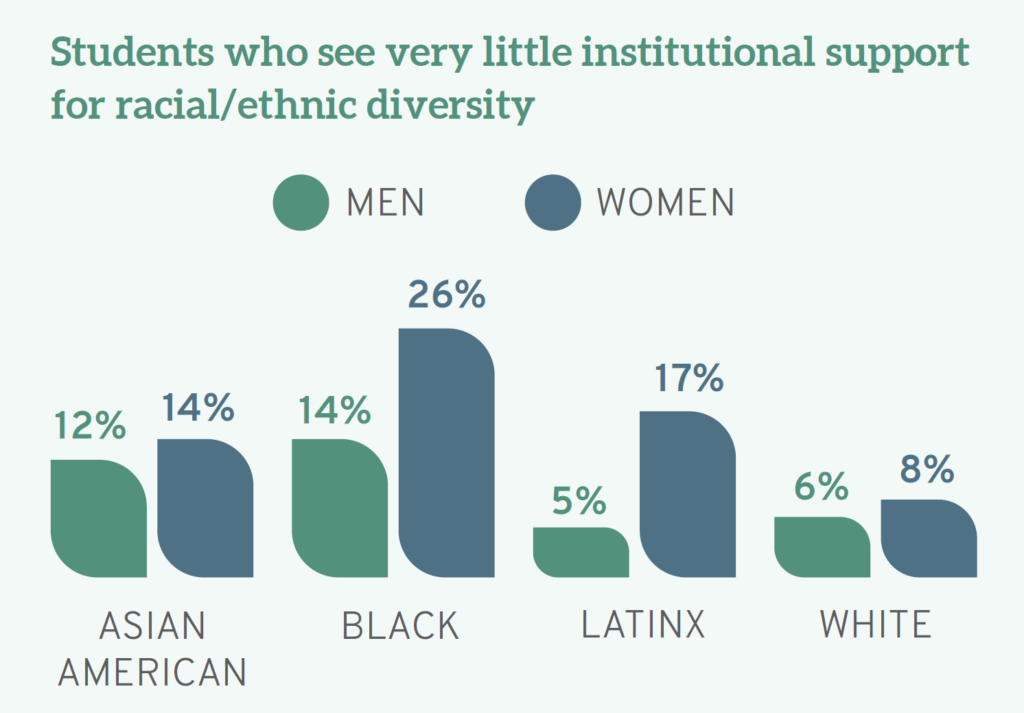
Disenchantment with the lack of support for diversity can be distilled even further. The Report notes that men varied on the issue of gender inclusivity, with 39% “very much” believing that their schools support gender diversity compared to 27% of women and 9% of individuals who identified with the “other gender” category.
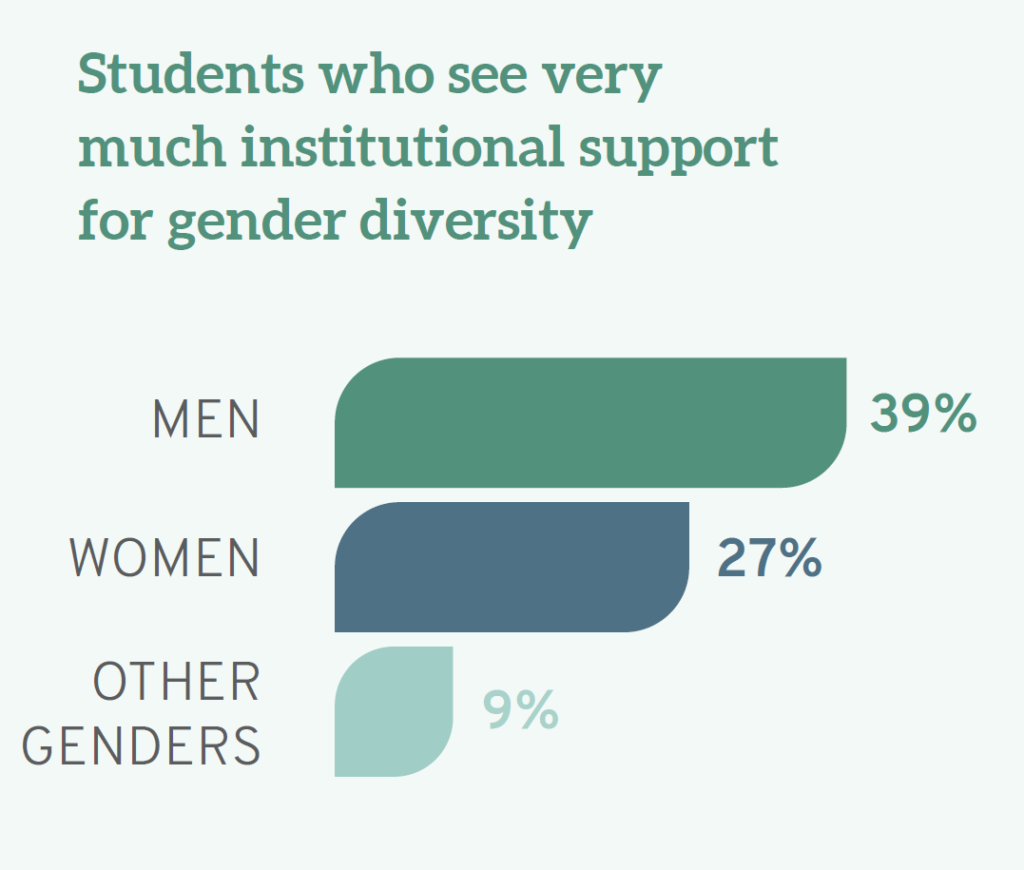
In the context of race, student views also differed, with 9% of White students, 14% of Native American students, 18% of Latinx students, and 25% of Black students believing that their schools do “very little” to ensure that students are not stigmatized based on identity.

Where sexuality and sexual orientation are concerned, 11% of heterosexual students think their schools do only “very little” to avoid identity-based stigma; conversely, 20% of gay students, 16% of lesbian students, 15% of bisexual students, and 19% of those who identify as another sexual orientation see their schools as doing “very little” in this regard. What do these findings mean for legal education and the political moment I gestured to in the beginning?
LSSSE’s data suggest that some students are dissatisfied with the six-figure education they are receiving. Put plainly, law students from backgrounds that the profession has historically excluded—women, racial minorities, LGBTQ communities, and people with disabilities in particular—do not feel part of the academic community and believe law schools are relatively disinterested in their stigmatization. In some ways, this is unsurprising, as there is a deep scholarly literature and genre of books on student disappointment with law school. Moreover, student disenchantment with legal education—which has a history of exclusion that traces back to the nativism and anti-Semitism of the early twentieth century—may in some ways be pre-determined.
The confines of the classroom, which is one of the many areas the LSSSE survey discusses, provides more insight into the inclusion-exclusion dyad. From the vantage point of some educators, law school is simply about training people to be lawyers. The most generous reading of this position suggests that social justice-like ideas like “inclusion” are too ideologically weighty to meaningfully bring in the classroom. For people who subscribe to this view, attempts at inclusion can create impossible-to-navigate landmines for professors. More skeptically, some see inclusion as an ancillary. Read in this light, the primary goal is to inculcate legal knowledge. For these professors, some things are not relevant to the practice of law and are therefore not relevant to legal education.
Such professional school-based views of legal education, vary in their reasonableness, but are held by swaths of the professoriate. Yet, there is a two-fold problem, and this is where the LSSSE survey is especially useful. First, this vision of legal education rubs up quite abrasively against the representations of law schools as bastions of inclusion. Second, this version of education, in some ways, undermines the well-touted “diversity rationale” in affirmative action jurisprudence. What does diversity mean when the subjects of diversity feel alienated?
Considering the mismatch between some students’ experiences and the stricter professional school model of legal education that some professors are beholden to, there are some options. Educators can simply be more intellectually honest about the reality that law school is a site of professionalization where inclusion principles can be trivialized. Alternatively, law schools can continue to disingenuously hitch the law school wagon to social justice rhetoric while failing to actualize inclusion as a practice. Or, in the most courageous and imaginative versions of themselves, law schools can refashion their curriculum and use developments in the legal world as opportunities to offer more inclusive learning environments.
For law schools committed to the third way, resources abound. Complaints about the need to diversify the content of law school courses have existed for decades. Scholars such as Derrick Bell and Dorothy Brown have authored casebooks that describe how race intersects with different areas of the legal curriculum, whereas feminist legal theorists, poverty researchers, scholars of law and sexuality have penned their own books, supplements, and articles that all give educational guidance on how to bring these issues into core courses, and do so in ways that are doctrinally sound. Still, some professors—many of whom have the most analytically sharp minds on their university campuses—throw their hands up in despair or continue with the same regularly scheduled program. For some of these instructors, these conversations were absent in their legal education, and they were likely not trained to incorporate these issues. Some may think it would be better to leave this work of thematic inclusion to their more expert colleagues (e.g., scholars of race, sex, class, disability) rather than wade into territory where they are sure to mess up. But throwing one's hands up in despair is increasingly a less credible course of action. The pandemic, along with the protests of 2020, have forced some people to rethink how they deliver course content, and more importantly, have made inequality a more prominent theme in our public discourse. The current socio-political moment, and the reality of pandemic pedagogy, call for curricular redesign.
Fortunately, the tools to make the classroom more inclusive are available and they are not limited to the usual courses. To be sure, law professors have written about how first-year courses like criminal law and property are inattentive to inequality in ways that produce the responses found in the LSSSE survey and have offered suggestions on how those same courses could easily be improved. But attempts to diversify and create a more inclusive curriculum are not confined to these foreseeable areas of law but can be found in more unsuspecting places like evidence, corporate law, trust and estates, and intellectual property, to name a few.
Law professors have also identified space in the curriculum for trans-substantive engagement with the kinds of questions and perspectives that demonstrate an awareness of inequality, both in legal education and in law more generally. Indeed, I, along with my colleague Karen Tani, have taken on the task of trying to simultaneously create an inclusive learning environment that rigorously addresses inequality by creating a 50-person Law and Inequality course at Penn Law. This endeavor and more meaningful engagements with diversity need not be limited to women, racial minorities, and sexual minorities. Inclusion also implicates and has meaning for the larger law student population. One of the most understated findings in the LSSSE Report is that 16 percent of white students believed law schools placed “very little” emphasis on issues of equity and privilege and do not prioritize providing students with the skills necessary to confront discrimination and harassment.
My purpose here is not to proselytize teaching a course like the one we are offering. Instead, I want to highlight how student dissatisfaction with inclusion, which the Report highlights in detailed and accessible fashion, can be situated within this critical juncture. 2021 is a unique moment where law schools can reimagine legal education in real time, and for a post-pandemic world. This will not be easy, as this is a stressful time for faculty—some of whom are in high-risk groups during the pandemic and/or have a variety of care obligations. COVID-19 has upended a lot of assumptions and forced people to change longstanding pedagogical practices. Institutions could do a lot of good by encouraging faculty reflection and supporting creative reorganization of current courses.
The LSSSE Report tells us that in many ways, law schools are failing to provide the inclusive educational spaces that they, I believe in good faith, want to offer and that students of various backgrounds actively desire. Ultimately, the teaching tools are available, the moment is ripe, and the only outstanding question is whether legal educators will make the changes necessary so that the next LSSSE survey offers more optimistic findings.
Annual Results 2020 Diversity & Exclusion: Diversity Skills
This year for the first time, LSSSE introduced a set of questions focused on diversity and inclusion that supplement related questions from the primary survey. The Diversity and Inclusiveness Module examines environments, processes, and activities that reflect the engagement and validation of cultural diversity and promote greater understanding of societal differences. The 2020 LSSSE Annual Results Diversity & Exclusion report presents data about how diversity in law school can prepare students for the effective practice of law upon graduation. In our final post in this series, we will explore how law schools can teach skills to equip students to interact with people from different backgrounds.
Schools have a responsibility to not only admit and provide the resources to enroll a diverse class of students, but to impart the skills these students will need to be effective lawyers. Increasingly, the practice of law requires sensitivity to issues of race/ethnicity, gender, sexual orientation, and socioeconomic status. Law schools can empower students first by encouraging them to reflect on their own identities, and then supplying coursework on issues of privilege, diversity, and equity; while it is important for students to learn about anti-discrimination and anti-harassment, law schools should also equip them with the tools they will need to fight these social problems as attorneys and civic leaders.
Yet schools are, by and large, not preparing law students to meet these challenges and succeed as leaders. When students were asked how frequently they reflect on their own cultural identity, only 12% of White students do so "very often," compared to 50% of Native American students, 44% of Black students, and 34% of Latinx students. Even more alarming, over a quarter (26%) of White students never reflect on their cultural identity during law school. When we consider the intersection of raceXgender, an even more troubling picture emerges. A full 28% of White men and 25% of White women in law school never reflect on their cultural identity, compared to the 50% of Black women who do so "very often."

Students whose parents have less formal education are also more likely to reflect on their cultural identity, including 34% of those whose parents did not finish high school as compared to 16% of those who have a parent with a doctoral or professional degree. In sum, students with racial, gender, or class privilege are less likely to reflect on the benefits associated with their identity.
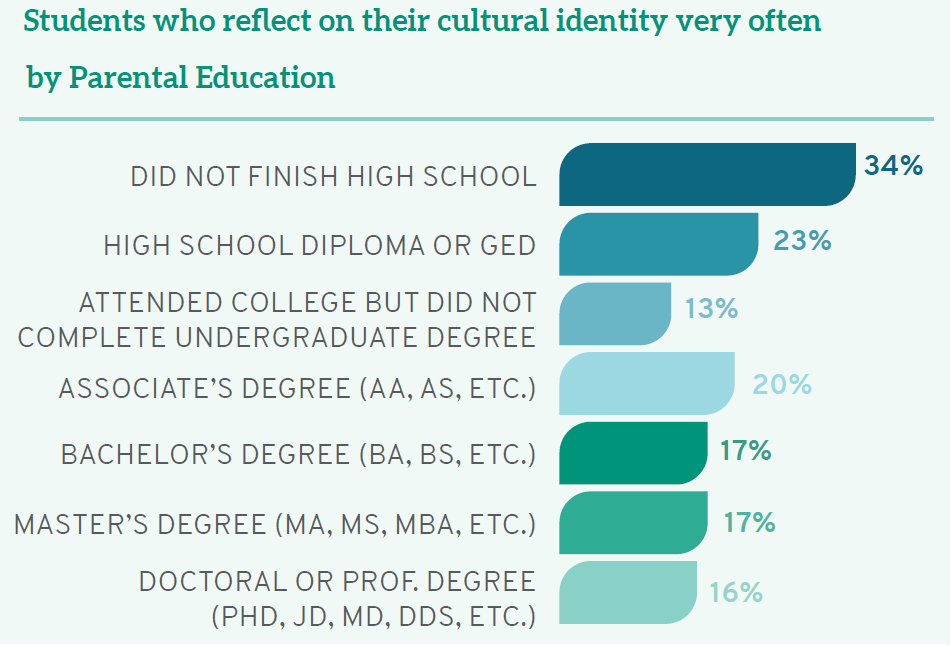
Even without self-reflection, students can nevertheless gather information about anti-discrimination and harassment policies. LSSSE data show that while White students see their schools as prioritizing this information, students of color do not agree at the same high levels. Similarly, men (31%) are more likely than women (23%) and those with another gender identity (11%) to believe their schools strongly emphasize information about anti-discrimination and harassment. Considering raceXgender, a full 27% of Black women see their schools as doing "very little" to share information on anti-discrimination and harassment, while 32% of White men believe their schools do "very much" in this regard.

Equally troubling, students from different backgrounds perceive institutional emphasis of various diversity-related topics in starkly divergent ways. Although White students believe that their schools emphasize issues of equity or privilege, respecting the expression of diverse ideas, and a broad commitment to diversity, students of color are less likely to agree. Students of color—including those who are Black, Latinx, Asian American, Native American, and multiracial—frequently note and appreciate assignments or discussions of race/ ethnicity and other identity-related topics in the classroom; yet they are more likely than their White peers to report that schools place “very little” emphasis on diversity issues. Women are similarly more likely than men to believe their schools do “very little” to emphasize diversity in coursework. Furthermore, higher percentages of Black women report “very little” emphasis on equity or privilege (36%), respecting diverse perspectives (27%), and an institutional commitment to diversity (21%)— compared to high percentages of White men who believe their schools are doing “very much” in all three arenas (20%, 24%, and 34%, respectively). First-gen students are also more likely than their classmates whose parents completed college to note “very little” diversity coursework. Synthesizing these data, students who are traditionally underrepresented and marginalized—arguably the students who have the most personal experience with issues of diversity—see their schools as doing less to promote diversity and inclusion than those who are privileged in terms of their race/ethnicity, gender, and parental education.

As part of a broad curriculum that sets up students for their future practice, law schools should teach students diversity skills—a set of skills that facilitate success in our increasingly globalized society, ranging from personal reflection to the tangible tools lawyers can use to combat discrimination. Law schools that succeed at these diversity-related endeavors will be preparing our nation’s newest lawyers to meet the full range of challenges ahead.
Annual Results 2020 Diversity & Exclusion: Sense of Belonging
This year for the first time, LSSSE introduced a set of questions focused on diversity and inclusion that supplement related questions from the primary survey. The Diversity and Inclusiveness Module examines environments, processes, and activities that reflect the engagement and validation of cultural diversity and promote greater understanding of societal differences. The 2020 LSSSE Annual Results Diversity & Exclusion report presents data about how diversity in law school can prepare students for the effective practice of law upon graduation. In this post, we explore how sense of belonging at law school varies among students from different backgrounds.
Scholarly research indicates that students who have a strong sense of belonging at their schools are more likely to succeed.1 Generally, belonging refers to feeling like part of the institutional community, fitting in, and being comfortable on campus.2 Using a number of separate indicators, LSSSE data on diversity and inclusiveness show that White students are more likely to have a strong sense of belonging than their classmates of color. For instance, when asked whether they feel they are "part of the community at this institution," a full 31% of White students strongly agree—though lower percentages of students of color do, including only 21% of Native American and Black students. Even more problematic when considering the importance of building an inclusive community: women of color are more likely than men from their same racial/ethnic backgrounds to feel that they are not part of the campus community—including a whopping 34% of Black women law students nationwide. First-gen students also deserve greater support, as only 23% "strongly agree" that they feel like part of the community at their law school, compared to 31% of students whose parents have at least a bachelor’s degree.
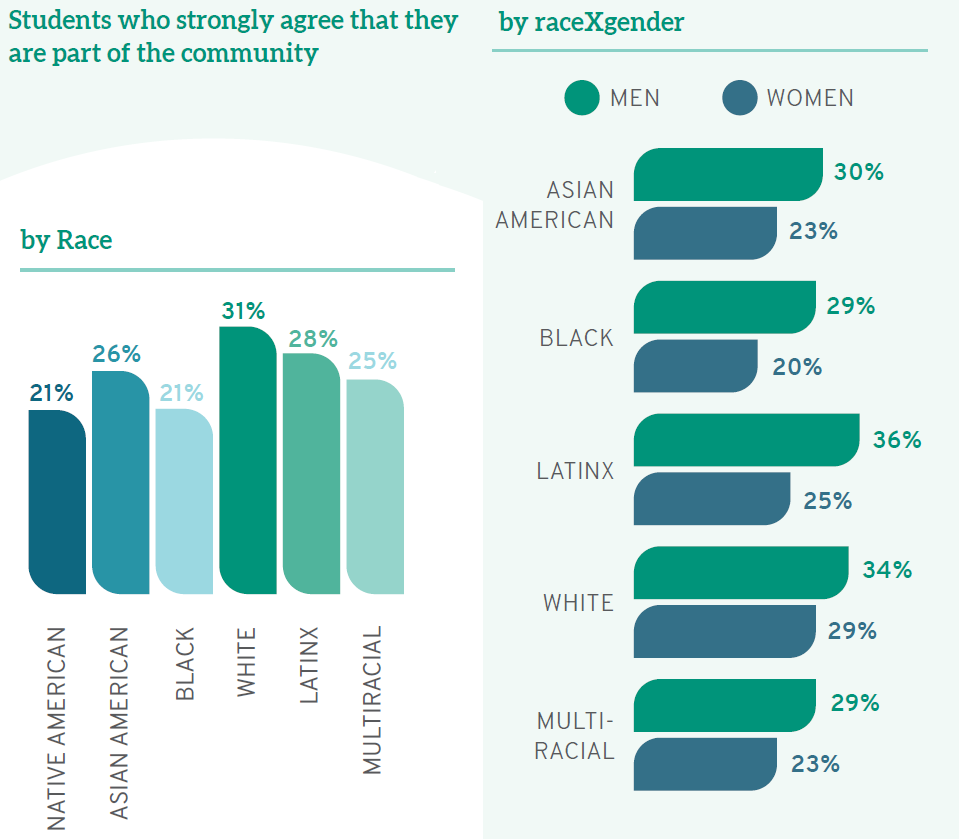
Students of color are also more likely than their White classmates to think their schools do "very little" to ensure students are not stigmatized based on various identity characteristics, including race/ethnicity, gender, religion, and sexual orientation. While only 9.3% of White students agree, 14% of Native Americans, 18% of Latinx students, and a full quarter (25%) of Black students believe their schools do "very little" to emphasize that students are not stigmatized based on identity. Similarly, 11% of heterosexual students think their schools do only "very little" to avoid identity-based stigma; conversely, 20% of gay students, 16% of lesbians, 15% of bisexual students, and 19% of those who identify as another sexual orientation see their schools as doing "very little" in this regard. Taken together, these findings suggest that those most likely to suffer stigma are also those most likely to think their schools do very little to protect them.
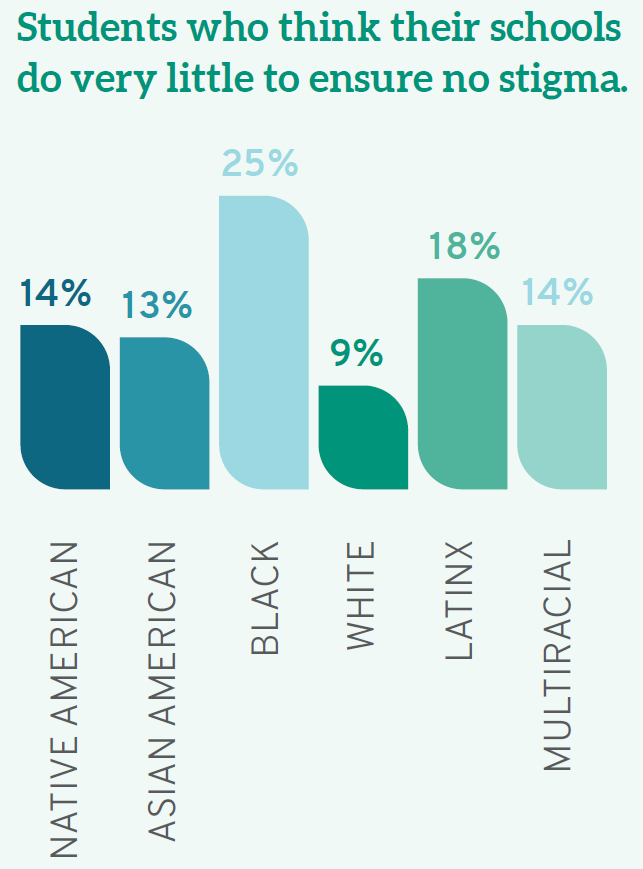
White students are also more likely than those from other backgrounds to be comfortable being themselves on campus, with only 12% noting they are not. Yet one out of every five (21%) law students who is Native American, Black, or Latinx notes that they do not "feel comfortable being myself at this institution."
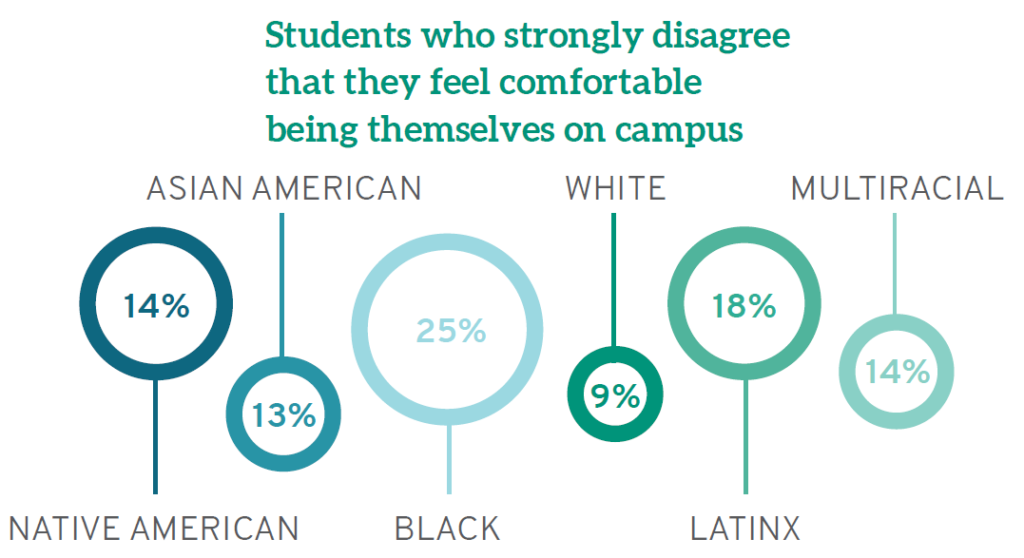
There are also disturbing disparities when considering parental education—a strong proxy for family socioeconomic status. Being comfortable on campus increases almost in lockstep with increases in parental education; a full 32% of law students whose parents did not finish high school are uncomfortable being themselves on campus, compared to just 12% of those who have a parent with a doctoral or professional degree.
The overarching theme from this report is that those who are most affected by policies involving diversity—the very students who are underrepresented, marginalized, and non-traditional participants in legal education—are the least satisfied with diversity efforts on campuses nationwide. Nontraditional students remain marginalized on campus, left out of the community, devalued, and underappreciated. The solution is clear: institutions should place greater emphasis on valuing students from all backgrounds, creating an inclusive community, and integrating diversity into the curriculum. With that foundation, law schools can prepare students to interact in meaningful ways with diverse clientele, to first recognize and then resist instances of discrimination or harassment, and to meet the many challenges they will confront in their roles as lawyers and leaders.
1 Kuh, G. D., Kinzie, J., Buckley, J. A., Bridges, B. K., & Hayek, J. C. (2006). What matters to student success: A review of the literature (ASHE Higher Education Report). San Francisco, CA: Jossey-Bass.
2 Strayhorn, T. L. (2018). College students’ sense of belonging: A key to educational success for all students. New York, NY: Routledge.
Annual Results 2020 Diversity & Exclusion: Institutional Support for Diversity
This year for the first time, LSSSE introduced a set of questions focused on diversity and inclusion that supplement related questions from the primary survey. The Diversity and Inclusiveness Module examines environments, processes, and activities that reflect the engagement and validation of cultural diversity and promote greater understanding of societal differences. The 2020 LSSSE Annual Results Diversity & Exclusion report presents data about how diversity in law school can prepare students for the effective practice of law upon graduation. In our next three posts, we will highlight key findings from the report and suggest some areas for improvement.
Support for diversity in law school must begin with the institution. Yet many students of color do not see their campus as supportive of racial/ethnic differences. Almost a quarter (23%) of Black law students nationwide say their schools do "very little" to create a supportive environment for race/ethnicity, compared to just 6.8% of White students. At the opposite end of the spectrum, 32% of White students believe their schools do "very much" to support racial/ethnic diversity, compared to only 18% of their Black classmates. Men (37%) are also more likely than women (26%) and those of another gender identity (7.5%) to believe their campus is very supportive of racial/ethnic diversity. Even more dramatic are intersectional identity findings, as a full 26% of Black women— more than any other raceXgender group—see their schools doing "very little" to create an environment that is supportive of different racial/ethnic identities, as compared to just 5.5% of White men (while 72% of White men believe their schools do "quite a bit" or "very much" in this arena).
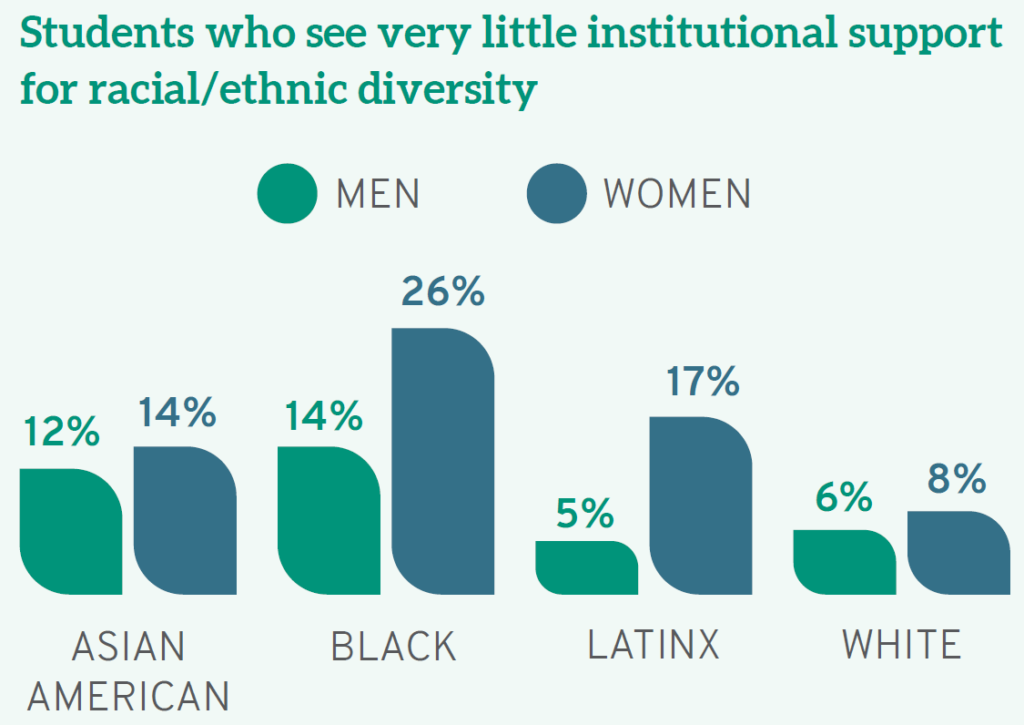
Men are also more likely to see their campus as a "supportive environment for gender diversity," with 39% believing this "very much" as opposed to 27% of women students, and only 9% of students who identify as another gender identity. Furthermore, White students as a whole (33%) see the campus as very supportive of people of different genders, compared to 21% of Native Americans and Black students. Again, the views of White male students differ significantly from most others with a full 40% seeing their campus as very supportive of gender difference. In short, women as well as others from less privileged groups do not see their schools as particularly supportive of gender inclusivity.
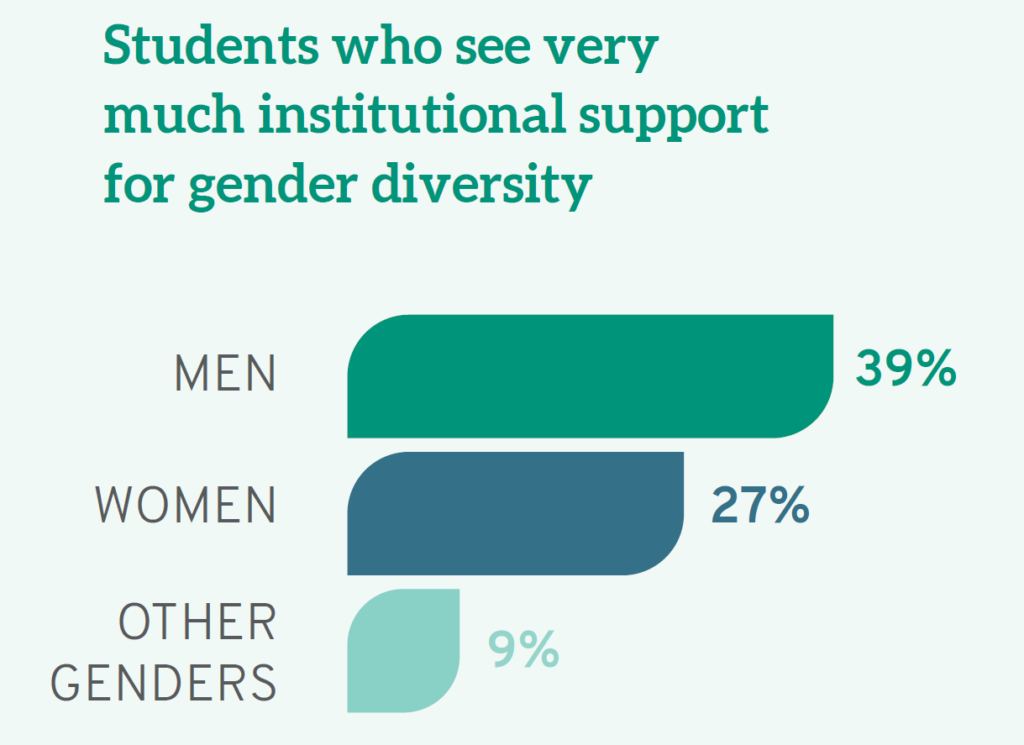
Not surprisingly, given the relative lack of support they see for racial/ethnic and gender diversity on campus, women and students of color also believe their schools are less invested in them as individuals. When asked whether they "feel valued" by their law school, a full 30% of men "strongly agree" compared to only 24% of women and 21% of those who identify as neither male or female. Similarly, the racial/ethnic group most likely to "strongly agree" is Whites (28%). In fact, while Latinos, White men, and Black men "strongly agree" that they are valued at roughly equal rates, men feeling more valued than women is consistent across every racial/ethnic group. Furthermore, students who are the first in their families to earn a college degree, often called "first-gen" students, feel less valued by their institution: a full third (33%) note they do not feel valued, compared to a quarter (25%) of others, which is also a significant proportion of law students overall.
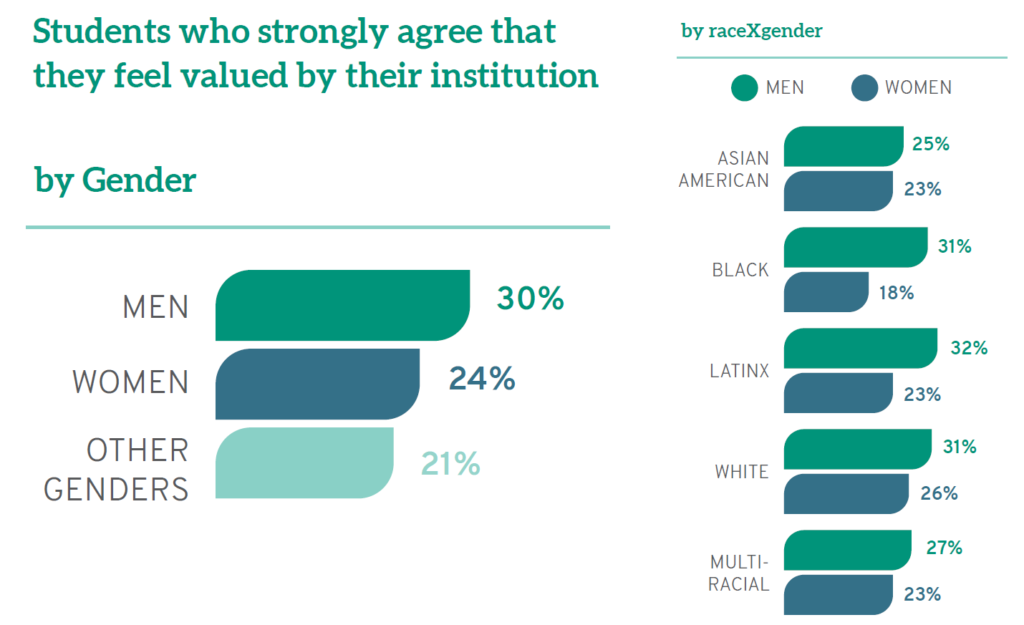
Institutions can put mechanisms in place to foster community among those on campus, regardless of their background or experiences. Finding this common ground helps all students understand that they belong and that others who may be different should be equally welcome. Again, White students are most likely to believe their institution emphasizes the importance of "creating an overall sense of community among students." While 28% of White students think their schools do this "very much," smaller percentages of students of color feel similarly. Even more disheartening, 18% of Black students and 14% of Latinx students think their schools do "very little" to foster community.

Many law schools have made concerted efforts to add student diversity to their campuses. But once students enroll, we owe it to them to provide a safe and welcoming environment, one where they feel valued, where they can be themselves, where they acquire the tools they need to succeed in the workplace, and where they can thrive. Admitting and even enrolling more students of color, first-gen students, students who identify as LGBTQ, and women is not enough unless that diversity is accompanied by inclusion. Law schools that want their students to succeed as future lawyers and leaders must commit to fostering a campus community where the most vulnerable and non-traditional are encouraged to reach their full potential, where faculty are expected to train students not only for the global marketplace but for the realities of American life, and where all students appreciate their own backgrounds, biases, and responsibilities to the profession.




